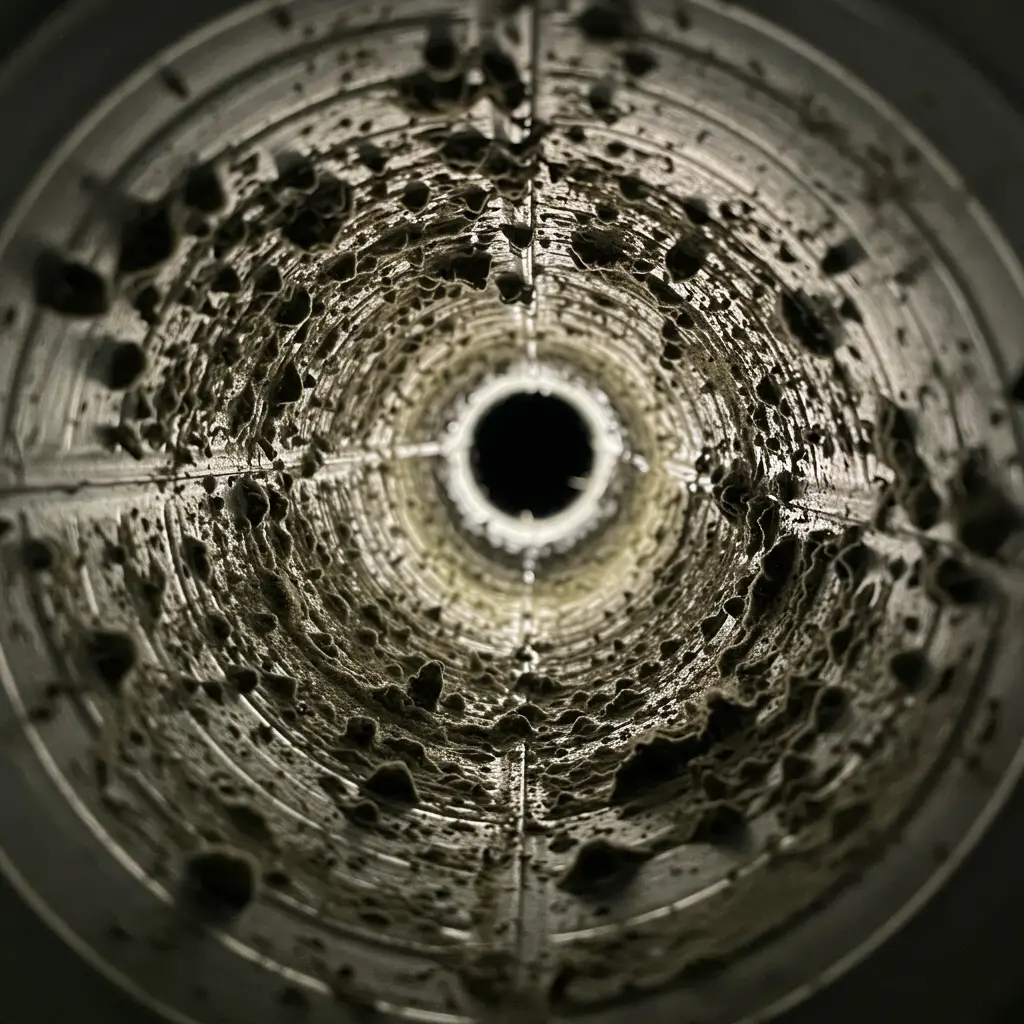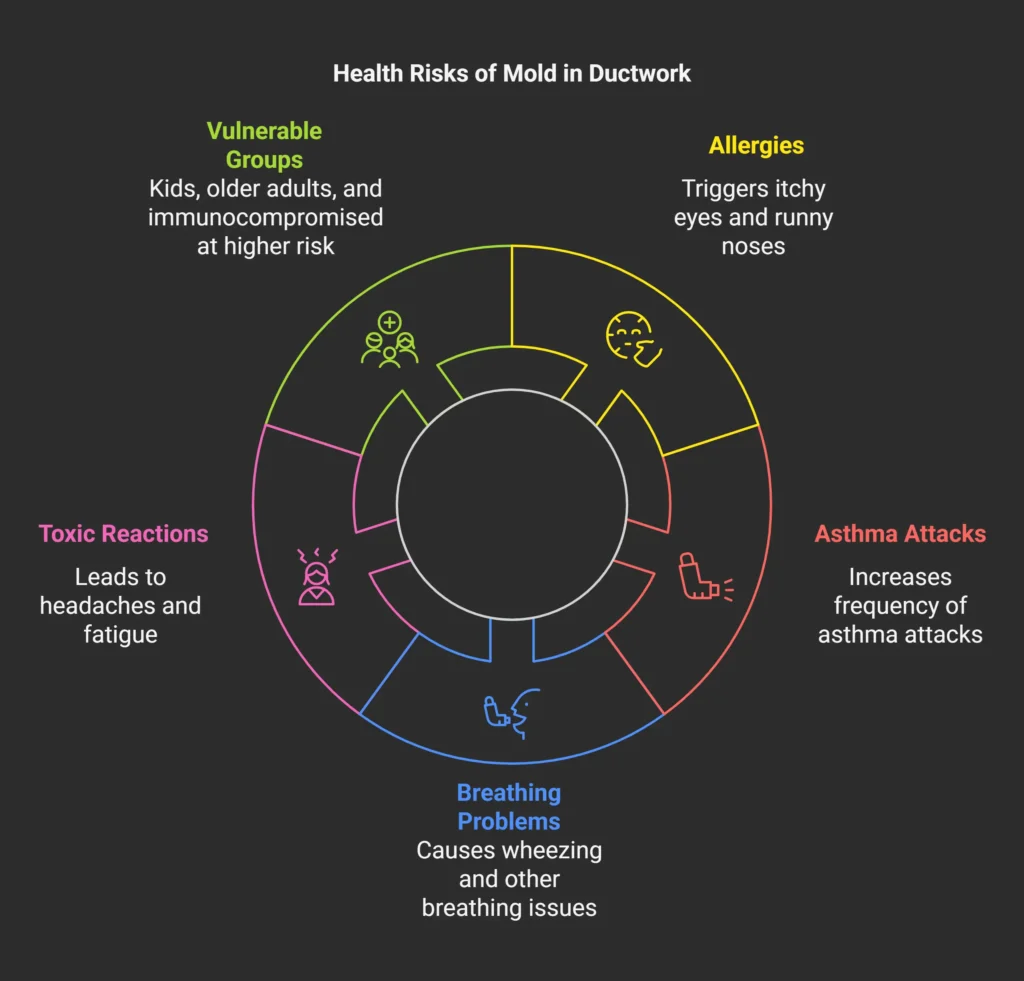Ductwork mold problems can quietly ruin the air quality in your home or office. When moisture builds up in HVAC systems, it creates a perfect spot for mold in ductwork.
This issue often comes from high humidity, leaks, or poor maintenance. Fixing ductwork mold problems quickly is crucial to protect your health and property.
In this article, we’ll cover the causes, signs, and solutions for mold in air ducts. Plus you’ll get tips to prevent it and answers to common questions.

What Causes Mold in Ductwork?
Mold loves damp places, and ductwork can be an ideal spot. High humidity causes condensation, which invites mold in ac duct work.
Poor ventilation traps moisture, while leaks—whether from rain or HVAC condensation—make things worse.
Dust and debris inside ducts also feed mold growth. Knowing what causes mold in air ducts is the first step to stopping it.
Signs of Mold in Ductwork
How do you spot mold in duct vents? A musty smell is a big clue, especially when your HVAC is running.
You might also see mold on vents or registers, though it can hide deeper in the system.
Watch for mold in air vents symptoms like coughing, sneezing, or worsening allergies. These signs mean it’s time to check your ducts.
Health Risks of Ductwork Mold

Mold in ductwork isn’t just a nuisance—it’s a health risk. It can trigger allergies, causing itchy eyes or runny noses, and make asthma worse with more frequent attacks.
Breathing problems, like wheezing, are also common. Some molds release toxins, leading to headaches or fatigue.
Kids, older adults, and people with weak immune systems are most at risk, so air duct mold removal is a must.
How to Get Rid of Mold in Ductwork
Cleaning mold in air ducts isn’t as simple as you might think. You can’t just turn off the HVAC, find the mold, and scrub it away with a wet brush or rag.
Even if you clean thoroughly, dispose of dirty water and rags properly, and avoid spreading spores, the mold often comes back.
Why? DIY methods and household cleaners can’t fully remove mold spores or fix the root causes.
For a lasting solution, professional mold remediation is the way to go. Experts use advanced techniques to physically remove mold and its spores while addressing the underlying issues.
Here’s why professional help matters:
- Full Inspection: They can reach hidden areas and find mold you might miss.
- Specialized Tools: They use HEPA vacuums and antimicrobial treatments to kill spores.
- Containment: They isolate the area to stop mold from spreading.
- Long-Term Fix: They tackle moisture problems and give prevention tips.
If the mold is in a small, visible area, you can try cleaning it yourself, but be careful:
- Fix Moisture: Repair leaks or lower humidity.
- Isolate the Area: Turn off the HVAC and cover vents with plastic.
- Clean Safely: Wear gloves, goggles, and a mask. Use a spray to kill mold in air ducts (like a mix of water, detergent, and baking soda). Spray, wait 15-20 minutes, scrub, rinse, and dry completely.
- Monitor: Keep an eye out to make sure mold doesn’t return.
DIY vs. Professional Cleanup
Use a spray to kill mold in air ducts and scrub carefully, but always wear protective gear.
For hidden or widespread mold, professional air duct mold removal is the best choice.
They have the tools to prevent spore spread and ensure a thorough cleanup. When in doubt, go with a pro.
Preventing Mold in Ductwork
Stopping ductwork mold problems before they start is the best approach. Here’s how to keep mold away:
- Keep It Dry: Mold thrives in damp places. Use a dehumidifier to keep humidity below 50% so condensation doesn’t form in ducts.
- Fix Leaks Fast: Water leaks in bathrooms, kitchens, or other rooms feed mold. Repair them as soon as you spot them to cut off mold’s water supply.
- Test Your HVAC: Check your HVAC system at least once a year for moisture, mold, or airflow problems. Follow the manufacturer’s advice on replacing air filters, usually every 1-3 months.
- Clean and Sanitize Ducts: Dust, debris, and moisture build up in ducts, creating a perfect spot for mold. Schedule professional duct cleaning every 3-5 years with experts like Dustless Duct to keep airflow healthy.
- Use UV Lights: Adding ultraviolet (UV) lights to your HVAC system kills mold spores and germs before they spread, improving indoor air quality.
Regular HVAC Maintenance
Routine care stops mold in duct vents in its tracks. Change filters every 1-3 months to reduce dust buildup, and schedule professional duct cleaning every 3-5 years.
Regularly check for leaks or damage in your system. A well-maintained HVAC means less chance of mold.
Conclusion
Ductwork mold problems threaten your air quality and health. Knowing the causes and spotting mold in air vents symptoms lets you act fast.
Clean mold carefully and maintain your HVAC to prevent it from coming back. If you suspect mold at ac vents, take action right away—your health depends on it.
Frequently Asked Questions
Is mold on air vents dangerous?
Yes, it can cause allergies, asthma, and breathing problems, especially with long-term exposure.
How much does HVAC mold removal cost?
HVAC mold removal cost depends on the job size—small fixes might cost $200-$500, while bigger jobs can go over $1,000.
How to clean mold out of vents?
For small areas, use a brush and a safe solution to clean it out of vents. For larger issues, hire a professional.
What are early signs of black mold in vents?
Early stage signs of black mold in air vents include musty smells, dark spots on vents, and rising allergy symptoms.




